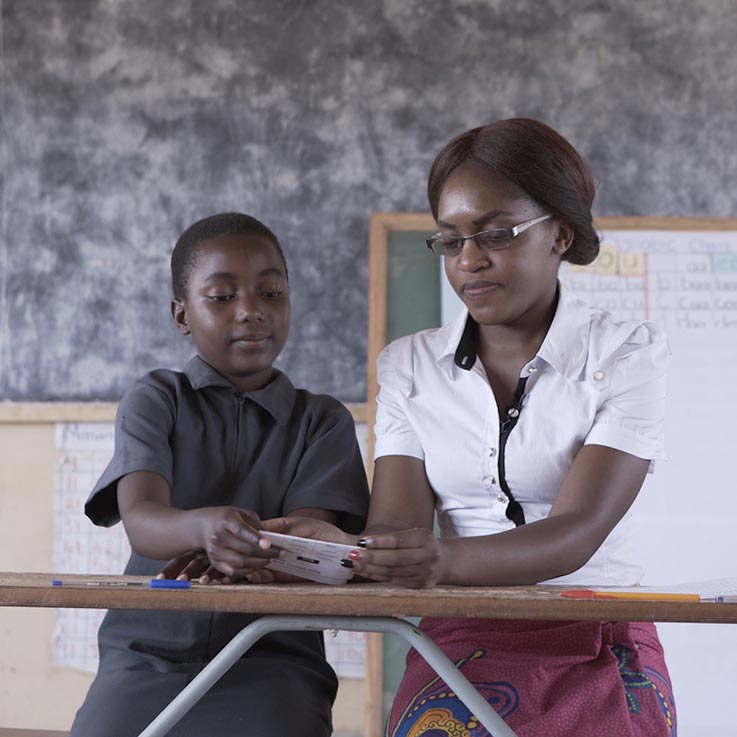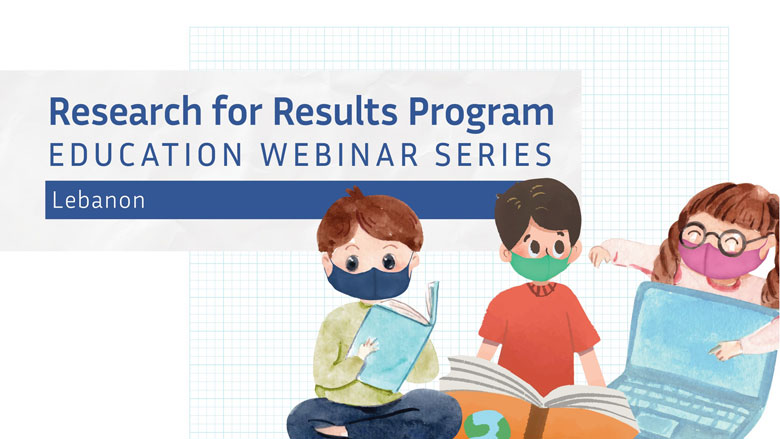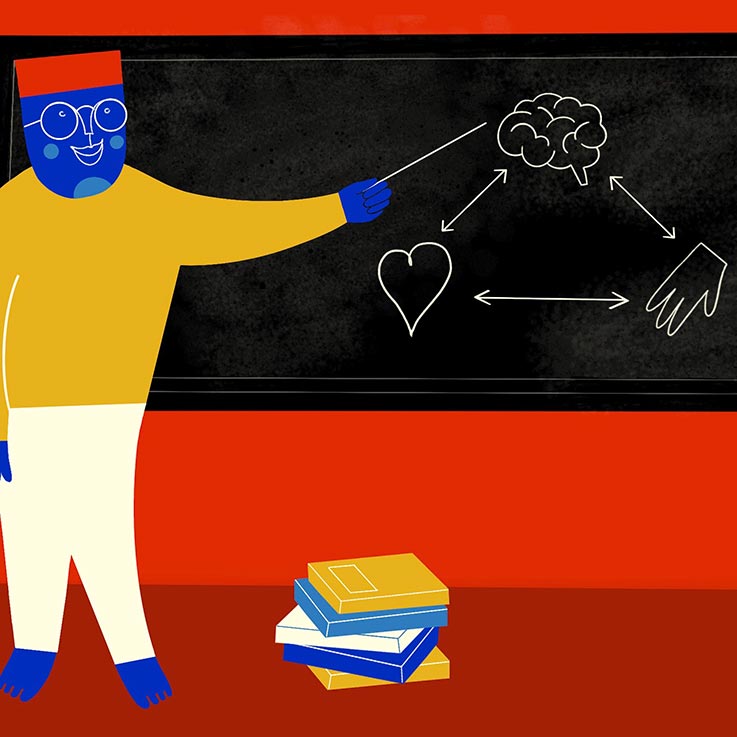
A Better Education for All During—and After—the COVID-19 Pandemic
A Better Education for All During—and After—the COVID-19 Pandemic
Research from the Abdul Latif Jameel Poverty Action Lab (J-PAL) and its partners shows how to help children learn amid erratic access to schools during a pandemic, and how those solutions may make progress toward the Sustainable Development Goal of ensuring a quality education for all by 2030.
By Radhika Bhula & John Floretta Oct. 16, 2020
Five years into the Sustainable Development Goals (SDGs), the world is nowhere near to ensuring a quality education for all by 2030. Impressive gains in enrollment and attendance over recent decades have not translated into corresponding gains in learning. The World Bank’s metric of “learning poverty,” which refers to children who cannot read and understand a simple text by age 10, is a staggering 80 percent in low-income countries.
The COVID-19 crisis is exacerbating this learning crisis. As many as 94 percent of children across the world have been out of school due to closures. Learning losses from school shutdowns are further compounded by inequities, particularly for students who were already left behind by education systems. Many countries and schools have shifted to online learning during school closures as a stop-gap measure. However, this is not possible in many places, as less than half of households in low- and middle-income countries (LMICs) have internet access.
Rethinking Social Change in the Face of Coronavirus
In this series, SSIR will present insight from social change leaders around the globe to help organizations face the systemic, operational, and strategic challenges related to COVID-19 that will test the limits of their capabilities.FOLLOW THIS SERIES
Many education systems around the world are now reopening fully, partially, or in a hybrid format, leaving millions of children to face a radically transformed educational experience. As COVID-19 cases rise and fall during the months ahead, the chaos will likely continue, with schools shutting down and reopening as needed to balance educational needs with protecting the health of students, teachers, and families. Parents, schools, and entire education systems—especially in LMICs—will need to play new roles to support student learning as the situation remains in flux, perhaps permanently. As they adjust to this new reality, research conducted by more than 220 professors affiliated with the Abdul Latif Jameel Poverty Action Lab (J-PAL) and innovations from J-PAL's partners provide three insights into supporting immediate and long-term goals for educating children.
1. Support caregivers at home to help children learn while schools are closed. With nearly 1.6 billion children out of school at the peak of the pandemic, many parents or caregivers, especially with young children, have taken on new roles to help with at-home learning. To support them and remote education efforts, many LMICs have used SMS, phone calls, and other widely accessible, affordable, and low-technology methods of information delivery. While such methods are imperfect substitutes for schooling, research suggests they can help engage parents in their child’s education and contribute to learning, perhaps even after schools reopen.
Preliminary results from an ongoing program and randomized evaluation in Botswana show the promise of parental support combined with low-technology curriculum delivery. When the pandemic hit, the NGO Young 1ove was working with Botswana's Ministry of Education to scale up the Teaching at the Right Level approach to primary schools in multiple districts. After collecting student, parent, and teacher phone numbers, the NGO devised two strategies to deliver educational support. The first strategy sent SMS texts to households with a series of numeracy “problems of the week.” The second sent the same texts combined with 20-minute phone calls with Young 1ove staff members, who walked parents and students through the problems. Over four to five weeks, both interventions significantly improved learning. They halved the number of children who could not do basic mathematical operations like subtraction and division. Parents became more engaged with their children's education and had a better understanding of their learning levels. Young 1ove is now evaluating the impact of SMS texts and phone calls that are tailored to students’ numeracy levels.
In another example, the NGO Educate! reoriented its in-school youth skills model to be delivered through radio, SMS, and phone calls in response to school closures in East Africa. To encourage greater participation, Educate! called the students' caregivers to tell them about the program. Their internal analysis indicates that households that received such encouragement calls had a 29 percent increase in youth participation compared to those that did not receive the communication.
In several Latin American countries, researchers are evaluating the impact of sending SMS texts to parents on how to support their young children who have transitioned to distance-learning programs. Similar efforts to support parents and evaluate the effects are underway in Peru. Both will contribute to a better understanding of how to help caregivers support their child’s education using affordable and accessible technology.
Other governments and organizations in areas where internet access is limited are also experimenting with radio and TV to support parents and augment student learning. The Côte d’Ivoire government created a radio program on math and French for children in grades one to five. It involved hundreds of short lessons. The Indian NGO Pratham collaborated with the Bihar state government and a television channel to produce 10 hours of learning programming per week, creating more than 100 episodes to date. Past randomized evaluations of such “edutainment” programs from other sectors in Nigeria, Rwanda, and Uganda suggest the potential of delivering content and influencing behavior through mass media, though context is important, and more rigorous research is needed to understand the impact of such programs on learning.
2. As schools reopen, educators should use low-stakes assessments to identify learning gaps. As of September 1, schools in more than 75 countries were open to some degree. Many governments need to be prepared for the vast majority of children to be significantly behind in their educations as they return—a factor exacerbated by the low pre-pandemic learning levels, particularly in LMICs. Rather than jumping straight into grade-level curriculum, primary schools in LMICs should quickly assess learning levels to understand what children know (or don’t) and devise strategic responses. They can do so by using simple tools to frequently assess students, rather than focusing solely on high-stakes exams, which may significantly influence a child’s future by, for example, determining grade promotion.
Orally administered assessments—such as ASER, ICAN, and Uwezo—are simple, fast, inexpensive, and effective. The ASER math tool, for example, has just four elements: single-digit number recognition, double-digit number recognition, two-digit subtraction, and simple division. A similar tool exists for assessing foundational reading abilities. Tests like these don’t affect a child’s grades or promotion, help teachers to get frequent and clear views into learning levels, and can enable schools to devise plans to help children master the basics.
3. Tailor children's instruction to help them master foundational skills once learning gaps are identified. Given low learning levels before the pandemic and recent learning loss due to school disruptions, it is important to focus on basic skills as schools reopen to ensure children maintain and build a foundation for a lifetime of learning. Decades of research from Chile, India, Kenya, Ghana, and the United States shows that tailoring instruction to children’s’ education levels increases learning. For example, the Teaching at the Right Level (TaRL) approach, pioneered by Indian NGO Pratham and evaluated in partnership with J-PAL researchers through six randomized evaluations over the last 20 years, focuses on foundational literacy and numeracy skills through interactive activities for a portion of the day rather than solely on the curriculum. It involves regular assessments of students' progress and is reaching more than 60 million children in India and several African countries.
Toward Universal Quality Education
As countries rebuild and reinvent themselves in response to COVID-19, there is an opportunity to accelerate the thinking on how to best support quality education for all. In the months and years ahead, coalitions of evidence-to-policy organizations, implementation partners, researchers, donors, and governments should build on their experiences to develop education-for-all strategies that use expansive research from J-PAL and similar organizations. In the long term, evidence-informed decisions and programs that account for country-specific conditions have the potential to improve pedagogy, support teachers, motivate students, improve school governance, and address many other aspects of the learning experience. Perhaps one positive outcome of the pandemic is that it will push us to overcome the many remaining global educational challenges sooner than any of us expect. We hope that we do.










